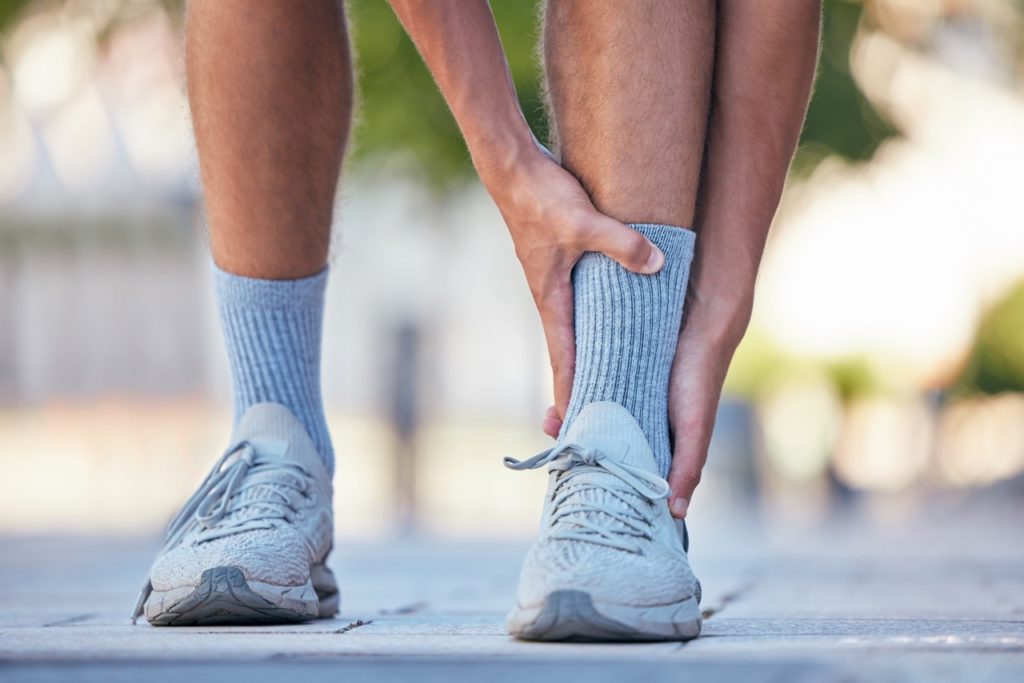What is the Achilles tendon?
The Achilles tendon is a white fibrous cord that connects the calf muscles, gastrocnemius and soleus, to the heel bone (calcaneus). It is the strongest tendon in the human body, located at the back of the ankle and is essential for walking, running, and jumping (LINK 1). The Achilles tendon is the largest tendon in the human body and can withstand over 1000 pounds of pressure.
Achilles tendon pain issues are often categorised into two zones: mid-portion and insertional problems.
The Achilles tendon allows the foot to flex by lifting the heel when the calf muscles contract. Without a functioning Achilles tendon, normal foot function, including walking, sports activity, running, etc, is compromised.
Causes of Achilles tendon pain
Generally, Achilles tendinopathy is caused by the overuse of the tendon. This can be simply due to the wear and tear that develops through daily life. Or as a result of increased loading and strain that occurs during many sports activities, especially high-impact sports activities. The Achilles tendon struggles to cope with the pressure, resulting in micro-tears and weakening of the structure, leading to tendinopathy. This is in fact damage to a very important tendon that links the lower leg and muscles to the heel and rear foot. The damage can be from minor to significant and will result in pain and loss of foot and lower limb function/mobility.
A tight Achilles tendon can lead to stiffness and pain in the calf muscle, as the tension affects the entire lower leg.
Symptoms and diagnosis of Achilles tendonitis
Common symptoms of Achilles tendinopathy
The symptom usually begins with mild pain at the back of the heel after running or sports activity. The common symptoms include:
- Heel pain and swelling at the back of the heel
- Thickening of the tendon
- Limited range of motion when flexing the foot
- The area around the heel may feel warm to touch
- Tenderness in the affected area
An Achilles tendon rupture is characterized by immediate, severe pain in the calf or heel, swelling, and often an audible snap in the tendon, necessitating immediate medical attention.
Varying levels of pain and morning stiffness are often the first symptoms of Achilles tendinopathy. They usually start gradually rather than suddenly. The pain may only come on after exercise initially but can develop into constant pain during activity. The pain level may increase if the Achilles strain continues, resulting in a debilitating condition
Chronic Achilles tendinopathy refers to persistent pain in the Achilles tendon that does not improve after six weeks. Non-surgical treatments, surgical treatment, and Platelet-Rich Plasma (PRP) injections are commonly discussed options for addressing this condition.
Achilles tendinopathy can often affect sports activity and normal activities of daily life.
How common is Achilles tendinopathy?
It is one of the most common sports injuries and can account for approx. 6-17% of all running injuries and up to 50% of injuries in elite athletes.
It can predominantly affect male athletes aged 30-40 years. (NICE, 2010)
However, it can also develop in 6% of nonathletic populations.
Diagnostic methods
Achilles tendinopathy is diagnosed through a comprehensive subjective and clinical assessment.
- Palpation of the Achilles tendon to elicit tenderness along the tendon.
- Active range of motion to elicit discomfort.
- Assessment of the thickness and consistency of the tendon and palpation for a discrepancy in thickness between the right and left legs.
- The range of motion of the ankle joint should also be evaluated.
- Ultrasound is the imaging modality of first choice as it provides a clear indication of the tendon’s width, changes in water content within the tendon and collagen integrity, and bursal swelling.
- X-rays can help rule out other conditions that can cause similar
Treatment options to treat Achilles tendinopathy
There are many treatment options for Achilles tendonitis:
Medications for pain relief
You can take over-the-counter pain medications with pharmacy advice — such as paracetamol or ibuprofen. If the pain is significant, your GP might prescribe stronger medications to reduce inflammation and relieve pain. Early detection and initial treatment options, such as resting, taking painkillers, and using ice packs, are crucial for effective Achilles tendinopathy treatment.
Physiotherapy treatment
Physiotherapy can help strengthen the Achilles tendon and improve flexibility. Advancements in tendinopathy treatment, including shockwave therapy and controlled tendon loading, have shown significant benefits in recent years.
A physiotherapist might suggest some of the following treatment options:
Six types of exercises
Physiotherapists often prescribe specific stretching and strengthening exercises to promote the healing and strengthening of the Achilles tendon and its supporting structures. A special type of strengthening called “eccentric” strengthening, involving a slow let down of weight after raising it, is especially helpful for persistent Achilles problems.
How an arch support can help
Simply explained – if the foot arch musculature is unable to support the arch structure, it will collapse. This creates a flat foot or pronated foot posture of varying levels. When the foot becomes pronated, the pressure and tension upon the Achilles Tendon increases with every step taken. With increased pressure and strain, the opportunity for the tendon fibres to recover is reduced, thus extending or preventing the healing process.
Various arch support actions to prevent tension within the Achilles Tendon are available.
To get arch support for Achilles Tendonitis, you can try:
- Supportive shoes
- Heel lifts or custom orthotics
- Taping, orthotics, or a brace with an air cell to lift the arch
- Compression ankle braces/sleeves
- Night splints
- Walking boots
- Splint at night to help the Achilles tendon stay stretched while you sleep
- Walking boot or walking cast if the pain is severe
- Don’t walk barefoot
- Orthotic Insole Long Term Arch Support
Orthotic insole devices: Can they offer a long-term solution?
A flat or pronated foot often requires long-term support. This action can also reduce the healing time for the damaged tendon fibres. Additionally, if the foot posture remains pronated, the potential for new or ongoing damage and a return of the problem remains. A return to ‘normal’ daily activity, including high-impact sports activity, is possible.
A shoe orthotic insert or wedge that supports the arch and slightly elevates your heel can relieve strain on the tendon and provide a cushion that lessens the amount of force exerted on your Achilles tendon.
The role of biomechanical assessment
- A biomechanical assessment can help identify any underlying issues that may be contributing to Achilles tendinopathy.
- The assessment can help identify issues such as overpronation, poor foot mechanics, and excessive stress on the Achilles tendon.
Benefits of digital scan biomechanical assessment for orthotic insoles
- Digital Foot and GaitScan can assess the entire foot function.
- A biomechanical assessment can help diagnose Achilles tendinopathy and identify the underlying causes.
- The amount of arch collapse and level of pronation can be accurately measured.
- Exact arch support and ankle position changes are determined.
- This produces an orthotic insole to reduce pain and inflammation and promote tendon healing and speedy recovery.
- It can also help prevent further injury and improve overall foot function.
- Don’t forget the other foot and Achilles tendon. The foot anatomy is often similar, and preventative foot posture changes are provided by an orthotic insole
Other treatment options
- Cold laser therapy stimulates the tendon’s natural healing process.
- Shockwave therapy produces a series of powerful sound waves that stimulate the tendon’s natural healing process.
- Injection steroid therapy is used to reduce pain and inflammation, allowing for effective rehabilitation.
Surgery
If several months of more conservative treatments don’t work or if the tendon has torn, your doctor may suggest surgery to repair your Achilles tendon. This is usually a last-case treatment option. Surgery is a serious procedure with a long recovery process. Referral to an Orthopaedic or Podiatric surgeon is required.
Book a biomechanical assessment at Waverley Clinic today!
Achilles tendinopathy is a common overuse injury that can cause pain and discomfort in the Achilles tendon. A Digital GaitScan Biomechanical Assessment can help diagnose and treat Achilles tendinopathy and promote tendon healing. A biomechanical assessment can help reduce pain and improve overall foot function by identifying and addressing underlying issues.
Prescription of custom orthotic insole inserts may be required. This can help to return the patient to an active life, including previous daily and sports activities. Orthotic Insoles help to ensure the Achilles tendon problem is resolved and foot posture enhancements reduce risks of problems developing in the opposite foot
If you have Achilles problems or feel they are developing, act now.
Call Waverley Clinic in Farnham on 01252 716611 to book a Biomechanical Assessment today!

